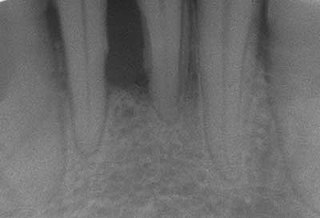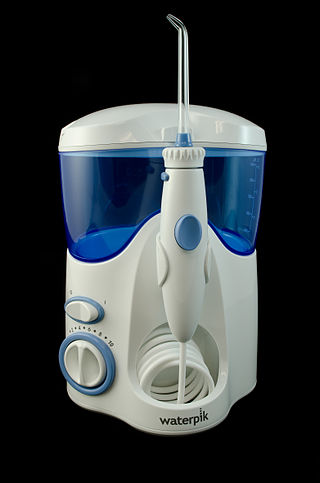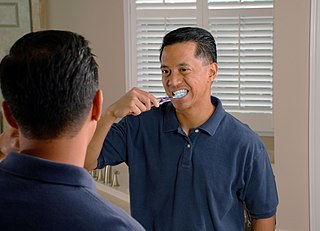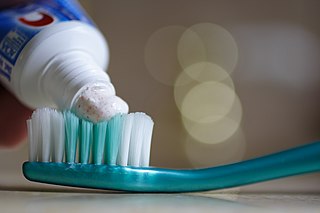Related Research Articles

Dentistry,also known as dental medicine and oral medicine,is the branch of medicine focused on the teeth,gums,and mouth. It consists of the study,diagnosis,prevention,management,and treatment of diseases,disorders,and conditions of the mouth,most commonly focused on dentition as well as the oral mucosa. Dentistry may also encompass other aspects of the craniofacial complex including the temporomandibular joint. The practitioner is called a dentist.

Periodontal disease,also known as gum disease,is a set of inflammatory conditions affecting the tissues surrounding the teeth. In its early stage,called gingivitis,the gums become swollen and red and may bleed. It is considered the main cause of tooth loss for adults worldwide. In its more serious form,called periodontitis,the gums can pull away from the tooth,bone can be lost,and the teeth may loosen or fall out. Bad breath may also occur.

A bridge is a fixed dental restoration used to replace one or more missing teeth by joining an artificial tooth definitively to adjacent teeth or dental implants.

The New York University College of Dentistry is the dentistry school of New York University. As the 3rd oldest dentistry school in the United States,it offers both graduate programs and clinical training in oral healthcare.
Periodontology or periodontics is the specialty of dentistry that studies supporting structures of teeth,as well as diseases and conditions that affect them. The supporting tissues are known as the periodontium,which includes the gingiva (gums),alveolar bone,cementum,and the periodontal ligament. A periodontist is a dentist that specializes in the prevention,diagnosis and treatment of periodontal disease and in the placement of dental implants.

Geriatric dentistry is the delivery of dental care to older adults involving diagnosis,prevention,management and treatment of problems associated with age related diseases. The mouth is referred to as a mirror of overall health,reinforcing that oral health is an integral part of general health. In the elderly population poor oral health has been considered a risk factor for general health problems. Older adults are more susceptible to oral conditions or diseases due to an increase in chronic conditions and physical/mental disabilities. Thus,the elderly form a distinct group in terms of provision of care.

An oral irrigator is a home dental care device which uses a stream of high-pressure pulsating water intended to remove dental plaque and food debris between teeth and below the gum line. Regular use of an oral irrigator is believed to improve gingival health. The devices may also provide easier cleaning for braces and dental implants. However,more research is needed to confirm plaque biofilm removal and effectiveness when used by patients with special oral or systemic health needs.

Tooth brushing is the act of scrubbing teeth with a toothbrush equipped with toothpaste. Interdental cleaning can be useful with tooth brushing,and together these two activities are the primary means of cleaning teeth,one of the main aspects of oral hygiene.The recommended amount of time for tooth brushing is two minutes.
Gingivectomy is a dental procedure in which a dentist or oral surgeon cuts away part of the gums in the mouth.

Dental Public Health (DPH) is a para-clinical specialty of dentistry that deals with the prevention of oral disease and promotion of oral health. Dental public health is involved in the assessment of key dental health needs and coming up with effective solutions to improve the dental health of populations rather than individuals.

Oral hygiene is the practice of keeping one's oral cavity clean and free of disease and other problems by regular brushing of the teeth and adopting good hygiene habits. It is important that oral hygiene be carried out on a regular basis to enable prevention of dental disease and bad breath. The most common types of dental disease are tooth decay and gum diseases,including gingivitis,and periodontitis.

Gingivitis is a non-destructive disease that causes inflammation of the gums;ulitis is an alternative term. The most common form of gingivitis,and the most common form of periodontal disease overall,is in response to bacterial biofilms that are attached to tooth surfaces,termed plaque-induced gingivitis. Most forms of gingivitis are plaque-induced.
Special needs dentistry,also known as special care dentistry,is a dental specialty that deals with the oral health problems of geriatric patients,patients with intellectual disabilities,and patients with other medical,physical,or psychiatric issues.
Evidence-based dentistry (EBD) is the dental part of the more general movement toward evidence-based medicine and other evidence-based practices. The pervasive access to information on the internet includes different aspects of dentistry for both the dentists and patients. This has created a need to ensure that evidence referenced to are valid,reliable and of good quality.

Trichomonas tenax,or oral trichomonas,is a species of Trichomonas commonly found in the oral cavity of humans. Routine hygiene is generally not sufficient to eliminate the parasite,hence its Latin name,meaning "tenacious". The parasite is frequently encountered in periodontal infections,affecting more than 50% of the population in some areas,but it is usually considered insignificant. T. tenax is generally not found on the gums of healthy patients. It is known to play a pathogenic role in necrotizing ulcerative gingivitis and necrotizing ulcerative periodontitis,worsening preexisting periodontal disease. This parasite is also implicated in some chronic lung diseases;in such cases,removal of the parasite is sufficient to allow recovery.

Tooth mobility is the horizontal or vertical displacement of a tooth beyond its normal physiological boundaries around the gingival area,i.e. the medical term for a loose tooth.

John C. Greene was an American dentist and public health administrator. He was a rear admiral in the U.S. Public Health Service Commissioned Corps,and served as the Deputy Surgeon General of the United States under President Carter from 1978 to 1981. He was the Acting Surgeon General from January to May 1981 under Ronald Reagan. He was the highest ranking non-physician public health officer in the history of the U.S. government.
Prenatal dental care is the care of the oral cavity during fetal development. The woman’s body is subject to hormonal changes leading to several physical changes in the oral cavity during pregnancy. Some of these changes may cause tooth decay,erosion and periodontal health changes.
Interdental cleaning or interproximal cleaning is part of oral hygiene where the aim is to clean the areas in between the teeth,otherwise known as the proximal surfaces of teeth. This is to remove the dental plaque in areas a toothbrush cannot reach. The ultimate goal of interproximal cleaning is to prevent the development of interproximal caries and periodontal disease. The combined use of tooth brushing,and mechanical and manual interdental cleaning devices has been proven to reduce the prevalence of caries and periodontal diseases.

Eugenia Lathy Mobley McGinnis was an American dentist. She was dean of the dental school and vice-president at Meharry Medical College in Nashville,Tennessee.
References
- 1 2 3 "Marita Rohr Inglehart | University of Michigan School of Dentistry". www.dent.umich.edu.
- ↑ "Reactions to critical life events : a social psychological analysis - KOC University Library".
- ↑ "Oral health-related quality of life - WorldCat".
- ↑ "Contemporary Pioneers in Human Learning and Development - Zayed University".
- 1 2 Bs, Henson; Mr, Inglehart; A, Eisbruch; Ja, Ship (January 19, 2001). "Preserved salivary output and xerostomia-related quality of life in head and neck cancer patients receiving parotid-sparing radiotherapy". Oral Oncology. 37 (1): 84–93. doi:10.1016/s1368-8375(00)00063-4. PMID 11120488.
- ↑ Filstrup, Sara L.; Briskie, Dan; da Fonseca, Marcio; Lawrence, Leslie; Wandera, Angela; Inglehart, Marita Rohr (June 19, 2003). "Early childhood caries and quality of life: child and parent perspectives". Pediatric Dentistry. 25 (5): 431–440. PMID 14649606.
- ↑ Valentine, Anthony Edward; Inglehart, Marita R. (September 19, 2011). "Medicaid patients in dental school clinics: do personal and professional experiences matter?". Journal of Dental Education. 75 (9): 1225–1235. doi:10.1002/j.0022-0337.2011.75.9.tb05166.x. hdl: 2027.42/153762 . PMID 21890852.
- 1 2 Krause, Meggan; Vainio, Lauren; Zwetchkenbaum, Samuel; Inglehart, Marita R. (November 19, 2010). "Dental education about patients with special needs: a survey of U.S. and Canadian dental schools". Journal of Dental Education. 74 (11): 1179–1189. doi:10.1002/j.0022-0337.2010.74.11.tb04991.x. hdl: 2027.42/153605 . PMID 21045222.
- ↑ Ji, Anderson; An, Patterson; Hj, Temple; Mr, Inglehart (January 19, 2009). "Lesbian, gay, bisexual, and transgender (LGBT) issues in dental school environments: dental student leaders' perceptions". Journal of Dental Education. 73 (1): 105–118. doi:10.1002/j.0022-0337.2009.73.1.tb04643.x. hdl: 2027.42/153661 . PMID 19126771.
- ↑ Hillenburg, Kenneth L.; Murdoch-Kinch, Carol A.; Kinney, Janet S.; Temple, Henry; Inglehart, Marita R. (December 19, 2016). "LGBT Coverage in U.S. Dental Schools and Dental Hygiene Programs: Results of a National Survey". Journal of Dental Education. 80 (12): 1440–1449. doi:10.1002/j.0022-0337.2016.80.12.tb06231.x. hdl: 2027.42/153556 . PMID 27934669.
- ↑ Inglehart, Marita R. (October 19, 2019). "Motivational Communication in Dental Practices: Prevention and Management of Caries over the Life Course". Dental Clinics of North America. 63 (4): 607–620. doi:10.1016/j.cden.2019.06.004. PMID 31470916. S2CID 201730291.
- ↑ "Oral Health Behavior Change and Oral Health Promotion | Request PDF".
- ↑ "Marita Rohr Inglehart". scholar.google.com.
- ↑ McComas, Martha J.; Doctor, Julianne; Inglehart, Marita R. (March 19, 2019). "Dental and Dental Hygiene Students' Perceptions of Status Quo, Benefits of, and Curricular Suggestions for Shared Learning: On the Road to IPE?". Journal of Dental Education. 83 (3): 322–333. doi:10.21815/JDE.019.028. hdl: 2027.42/153574 . PMID 30692182. S2CID 59341095.
- ↑ Richards, Philip S.; Inglehart, Marita R. (March 19, 2006). "An interdisciplinary approach to case-based teaching: does it create patient-centered and culturally sensitive providers?". Journal of Dental Education. 70 (3): 284–291. doi:10.1002/j.0022-0337.2006.70.3.tb04084.x. hdl: 2027.42/153681 . PMID 16522757.
- ↑ Ac, Grillo; Ca, Murdoch-Kinch; V, Ramaswamy; Mr, Inglehart (April 19, 2016). "Student Evaluations of Teaching: Dental and Dental Hygiene Students' and Faculty Members' Perspectives". Journal of Dental Education. 80 (4): 439–451. doi:10.1002/j.0022-0337.2016.80.4.tb06102.x. hdl: 2027.42/153635 . PMID 27037452.
- ↑ Cain, Lisa; Brady, Michelle; Inglehart, Marita R.; Istrate, Emilia C. (September 19, 2022). "Faculty diversity, equity, and inclusion in academic dentistry: Revisiting the past and analyzing the present to create the future". Journal of Dental Education. 86 (9): 1198–1209. doi:10.1002/jdd.13013. hdl: 2027.42/174905 . PMID 36165257. S2CID 252541478.
- ↑ Albino, Judith E. N.; Inglehart, Marita R.; Tedesco, Lisa A. (January 19, 2012). "Dental education and changing oral health care needs: disparities and demands". Journal of Dental Education. 76 (1): 75–88. doi:10.1002/j.0022-0337.2012.76.1.tb05236.x. hdl: 2027.42/153776 . PMID 22262552.
- ↑ Seacat, Jason P.; Inglehart, Marita Rohr (June 19, 2003). "Education about Treating Patients with HIV Infections/AIDS: The Student Perspective". Journal of Dental Education. 67 (6): 630–640. doi:10.1002/j.0022-0337.2003.67.6.tb03663.x. PMID 12856963.
- ↑ Nesbitt, Paula E.; Inglehart, Marita R.; Sinkford, Jeanne C. (August 19, 2003). "Work environment perceptions of full-time dental educators: does gender matter?". Journal of Dental Education. 67 (8): 916–924. doi:10.1002/j.0022-0337.2003.67.8.tb03679.x. PMID 12959166.
- ↑ Dehaitem, Maryam J.; Ridley, Karen; Kerschbaum, Wendy E.; Inglehart, Marita Rohr (September 19, 2008). "Dental hygiene education about patients with special needs: a survey of U.S. programs". Journal of Dental Education. 72 (9): 1010–1019. doi:10.1002/j.0022-0337.2008.72.9.tb04575.x. hdl: 2027.42/153598 . PMID 18768443.
- ↑ Jh, Lee; De, Bennett; Ps, Richards; Mr, Inglehart (February 19, 2009). "Periodontal referral patterns of general dentists: lessons for dental education". Journal of Dental Education. 73 (2): 199–210. doi:10.1002/j.0022-0337.2009.73.2.tb04655.x. hdl: 2027.42/153664 . PMID 19234076.
- ↑ Furgeson, Danielle; Kinney, Janet S.; Gwozdek, Anne E.; Wilder, Rebecca; Inglehart, Marita R. (November 19, 2015). "Interprofessional Education in U.S. Dental Hygiene Programs: A National Survey". Journal of Dental Education. 79 (11): 1286–1294. doi:10.1002/j.0022-0337.2015.79.11.tb06024.x. hdl: 2027.42/153608 . PMID 26522633. S2CID 1171906.
- ↑ Sytek, Lauren; Inglehart, Marita R.; Ramaswamy, Vidya; Aronovich, Sharon; Edwards, Sean; Kim‐Berman, Hera (August 19, 2021). "Comparisons of orthodontic residents' performance and attitudes using 2D, 3D, and virtual reality surgical simulation methods". Journal of Dental Education. 85 (8): 1415–1426. doi:10.1002/jdd.12598. hdl: 2027.42/169275 . PMID 33792038. S2CID 232482431.
- ↑ Taichman, L. Susan; Inglehart, Marita; Giannobile, William; Braun, Thomas; Kolenic, Giselle; Van Poznak, Catherine (May 20, 2013). "Periodontal health in early-stage postmenopausal breast cancer survivors on aromatase inhibitors". Journal of Clinical Oncology. 31 (15_suppl): 568. doi:10.1200/jco.2013.31.15_suppl.568.
- ↑ Taichman, L. Susan; Van Poznak, Catherine H.; Inglehart, Marita R. (November 19, 2016). "Self-reported oral health and quality of life of postmenopausal breast cancer survivors on aromatase inhibitors and women without cancer diagnoses: a longitudinal analysis". Supportive Care in Cancer. 24 (11): 4815–4824. doi:10.1007/s00520-016-3336-6. PMC 5614704 . PMID 27455851.
- ↑ Suminski, Jennifer A.; Inglehart, Marita; Munz, Stephanie M.; Van Poznak, Catherine H.; Taichman, L. Susan (June 1, 2017). "Oral Care: Exploring Education, Attitudes, and Behaviors Among Nurses Caring for Patients With Breast Cancer". Clinical Journal of Oncology Nursing. 21 (3): 371–378. doi:10.1188/17.CJON.371-378. PMID 28524905. S2CID 4553930.
- ↑ "The Impact of Possible Selves on Academic Achievement--A Longitudinal Analysis. - ED" (PDF).
- ↑ "Reactions to Critical Life Events: A Social Psychological Analysis - KOC University Library".
- ↑ Zajonc, R. B.; Murphy, S. T.; Inglehart, M. (July 19, 1989). "Feeling and facial efference: implications of the vascular theory of emotion". Psychological Review. 96 (3): 395–416. doi:10.1037/0033-295x.96.3.395. PMID 2756066.
- ↑ "Here, There, Everywhere". APS Observer. 29. August 31, 2016.
- ↑ "Six receive 2019 Harold R. Johnson Diversity Service Awards | The University Record". record.umich.edu.
- ↑ "Carol Hollenshead Inspire Award Winners". issuu.
- ↑ "Marita Inglehart among U-M faculty to receive new diversity professorship appointment - U-M Dentistry News". September 19, 2019.